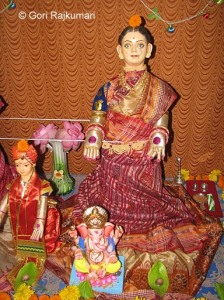Ganesha Festival is one of a kind in Hinduism. It’s when mother and son are worshipped together.
The other name for Goddess Parvati (also known as Lakshmi or Mahalaxmi), the mother of Ganesha, is Gauri. There are many different interpretations of the festival which changes from households to localities, however no matter where the festival, the Goddess is worshipped with full devotion. In our family home, the Goddess is welcomed home a day before Ganesha Chathurthi.
My family deity is Mahalakshmi and the temple that we pray at is the Kolhapur temple.
New laws was enacted allowing women (for the first time in over 2000 years) to entire the temples proper and touch the feet of the statue of Mahalakshmi as well as enter to perform puja. While many derided it, many more (women) devotees were glad to hear the news that they would finally be able to pray at the feet of their family Goddess.
Devotees believe that bringing home Goddess Gauri will bring them wealth and prosperity. Some regions consider Gauri Pooja as upasana of Goddess Lakshmi.
In our family, the Gauri Festival is celebrated on the seventh, eighth, ninth of Bhadrapada Shukla paksha. Although we keep it for five days total, the actual prayer and puja is only for those three days. The day before and the day after are considered preparation for us to welcome the arrival and leave taking of Gauri. She is worshipped as the goddess of harvest and protectress of women. We have three bronze vessels that hold the grains important to our household.
Goddess Gauri is kept and worshipped for three days – first day is the avahana, and this is when the Goddess is brought into the home. The preparations for Gauri pooja are made in the same way as Ganpati, married women within the house mark footsteps of Goddess by using Rangoli (colorful powder) and then the idol of Goddess Gauri is brought home. This year, Aai asked me to mark the footsteps of Goddess into the home. It’s a simple and artistic task which helps you focus on the reason behind the ritual and to become closer to the Goddess.
In our family, Gauris arrive in a pair, one as Jyeshta (the Elder one) and another as Kanishta (the Younger one). The vessels that hold the grain are also the base for the Gauris “bodies” and their head is placed on top of these bodies after a puja to welcome them. That evening, the married ladies in the home ‘dress’ Gauri in a new Sari and adorn her with wedding jewelry, mangalsutra, nose ring, toe rings, bangles and earrings. This year, Aai also gave me one of the Gauri to dress in Sari and jewelry. This very special for me, especially since everyone knows my poor sari wrapping skills! Here is the Gauri that I dressed:
Here is the one Aai dressed:
The next day is Satyanarayan puja which is a puja that most families use before or during any major occasion. While it can be used on any day for any reason, in our family the puja is used for special occasions and during times of achievements as an offering of gratitude to the Lord.
Then at mahurat (auspicious timings), Naivedya (offering) is presented before Goddess and the ritual is followed by singing aarti (holy song) and praying to Goddess for health, wealth, success and prosperity.
There are many sweets to be eaten on this day. Aai prepares the special food that we serve to the Goddess’ first. Everyone leaves the room to give the Goddess’ peace and quiet. Then we return and it is the men, children and guests turn to eat. Afterwards, the ladies eat.
On the third day our family hosts Haldi Kumkum as well as this being the day that Gauri and Ganesha are immersed in water (this is our family’s tradition). This year Bear and I had to leave the morning of the immersion, so we missed this.
However, last year we did this with Baba at a local Mumbai park which was dedicated for Pooja and Immersion during Ganesha Chathurthi. We carefully carried our Ganesha near to the river and performed a pooja. Then we brought out Ganesha to the dais and received blessings from a Guru. Then our Ganesha idol was immersed into the river with hundreds of other’s with many of us standing on the banks shouting “Ganpati Bappa Morya!”
Later that day, Aai hosts a Haldi Kumkum ceremony where married ladies are invited into our home, given sweets and a gift as well as being sprinkled with rose water, having perfume applied to their wrists and then Haldi Kumkum is applied to their foreheads. The ladies spend time chatting while the men hide in another room.
That evening, the family immerse Gauris and perform the final pooja for the Goddess. After the pooja, the idols are loving packed and put away for the next year. The jewelry is stored in a locked cabinet. The sari’s are given to Aai and Vahini (I am given a special Kurta that has been displayed with the Gauris). And the dais and decorations are put away.
The fifth day (next day) the family rests and eats light foods while trying to avoid travelling or strenuous work.
How does your family celebrate Ganesha Chathurthi and Gauri Pooja? If you don’t celebrate these, what is your favorite family tradition or holiday?





